Don't wanna be here? Send us removal request.
Text
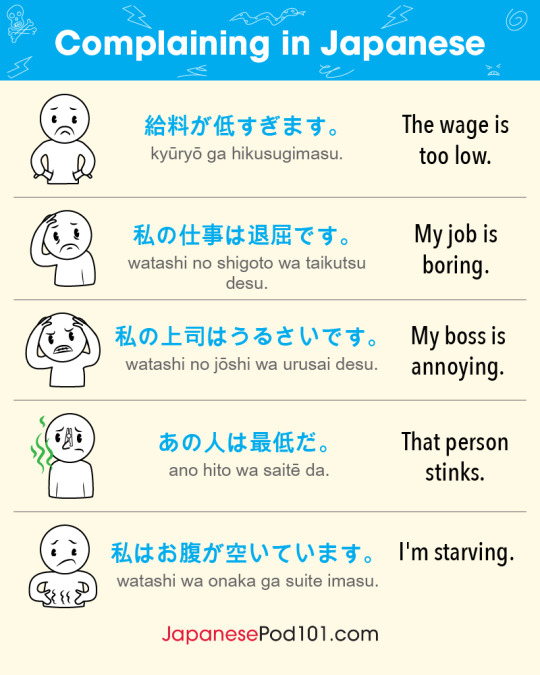
Complaining in Japanese! 😬 P.S. To get the best FREE Japanese online resources, just click here: https://www.japanesepod101.com/?src=tumblr_infographic_complaining_012825
31 notes
·
View notes
Text
JLPT N5 - している [Part 1]
している is a grammar point that is very very important in Japanese. The “して” part represents a verb in the て form. The “いる” part is the verb いる, which will change to different forms (for example います、る or ます).
している actually appears in several levels of the JLPTs - from N5 all the way to N2! As for the N5 level, there are 2 main ways that you will see it used. In this post let’s look at one of them!
First, here is your vocabulary.

【Repeated Actions】
First let’s look at how している is used with repeated actions. These actions are mostly physical.

= I climb Mt. Fuji every year.
Notice the two highlighted words, 毎年 and 登って. If 毎年 weren’t there you would almost always translate 登っています as “am climbing”. However, because 毎年 expresses repetition, it forces us to translate 登っています as “climb”.

= Traffic accidents happen on this street often.
起きる is a verb that can mean “to wake up” or “to occur”. If sentence #2 didn’t have the word よく it would be understandable to translate 起きています as “are occurring”. However because of the よくwe understand that there is repetition and so we go with the “occur” translation instead.

= Well you see, Dad has been going to China for work once a month since last year.
This time the word / phrase that expresses repetition is 毎月1回 meaning “once a month”. This tells us that 行ってる is “goes” instead of “is going”. Also, the い in the helping verb いる can be dropped, making 行ってる a more casual way of saying 行っている. It also works for います so that 行ってます is more casual than saying 行っています。
Finally, take a look at the nuance section. This んです is actually a different JLPT grammar point. The gist is that it’s used when you want to answer a question with extra details that you think the listener/reader wants to know. The ん is a shortened version of the particle の.
【Occupation or Social Position】
している is also used to talk about someone’s occupation or social position.

= Taiki teaches Japanese at a Thai university.
There is no period of repetition stated outright, but we understand that teaching is a job that you do over and over. Thus, you should use 教えています instead of 教えます。

= Aya is a trading company manager.
In this case, the しています simply means “is” or “has the position of”.

= My little brother studies European history at a German university.
This last example is a good one to remember. Most times, if you say 勉強しています it will mean “currently studying”. However when it comes to being a student, the translation shifts to “studies (for an extended period of time)”. Actions that can be interpreted either way (like studying) will sometimes have time words / phrases like 今 (now) or 2、3時間 (for a few hours). That tells you that it is an action in progress. Other than those kinds of phrases, usually the meaning will be repetitive.
【Conclusion】
So there you have it! The first している is associated with repeated actions, occupations, or positions in society or work. It’s fairly easy to figure out if the sentence is talking about an occupation or a position. For repeated actions, the key is to look for words / phrases that express repetition and remember that they cause you to use the している version of your verb. With that, you should be fine!
Rice & Peace,
– AL
👋🏾
54 notes
·
View notes
Text
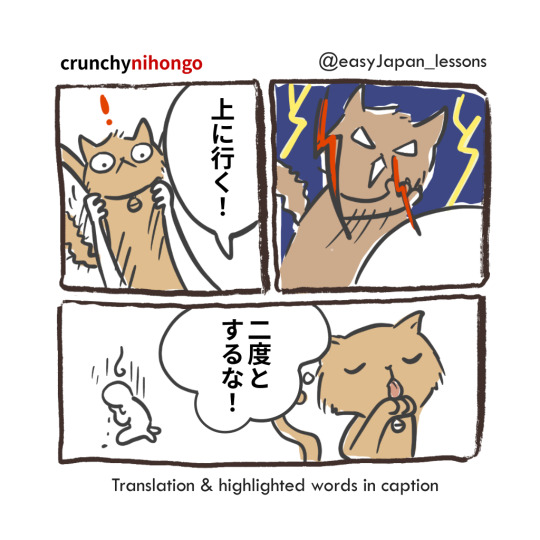
Learn Japanese from comic strip!
上に行く! Ue ni iku! "(Go) up!"
上 (うえ | ue) "Up" or "above."
Indicates direction or position. Often paired with particles like に or の.
に (ni) Particle indicating direction or target of an action. Shows the direction of movement (to up).
行く (いく | iku) "To go." Dictionary form (plain present tense). Indicates movement to a destination.
Grammar: [Place] + に + [Verb of Movement]: A common pattern to describe going/moving to a specific place or direction. Example: 学校に行く (Gakkou ni iku) – "Go to school."
二度とするな! Nidoto suru na! "Never do (it) again!"
二度と (にどと | nidoto) "Never again." A strong negative expression used with prohibitive or negative verbs.
する (する | suru) "To do." Refers to "doing" the action mentioned in context (lifting the cat).
な (な) Prohibitive particle. Used in casual speech to strongly forbid or prohibit an action.
Example: 行くな (Iku na) – "Don’t go!"
[Verb] + な: A prohibitive form used to command someone not to do something. Example: 見るな (Miru na) – "Don’t look."
46 notes
·
View notes
Text
JLPT N5 - している [Part 2]
Hey everyone, welcome to Part 2 of talking about している. This N5 grammar point is very basic but also very important. Let’s get into it shall we!
But first, here is your vocabulary:

【English Helping Verbs】
As I mentioned in Part 1, the “して“ in している can stand for any verb in て form. Sometimes it is actually する, but most times it will be some other verb.
Ok great, but what is the いる part?? Take a look at the following English sentences:
① Traffic accidents often occur here.
② I am eating.
③ The window is open.
Two of these sentences have both a helping verb and a main verb. In #1, there is only a main verb, which is “occur”. In #2 the main verb is “eating” and the helping verb is “am”. In #3 the main verb is “open” and the helping verb is “is”. Notice that one of the main verbs has the -ing suffix while the other two don’t. Make a mental note of this for later. 😉
【The いる in している】
Japanese also has helping verbs. Allow me to introduce you to one of the most common ones: いる!
The いる helping verb* adds nuance to the main verb. But here’s the thing - there are different versions of いる!In the している Part 1 article, you actually saw what I call the いる of Repetition. This いる does not translate to the -ing form of our verbs in English. If you see よく起きている for example, you should think “often occur(s)”. This is similar to example #1 above.
Examples #2 and 3 are not actions of repetition. For them, we need the other いる, which I call the いる of State or Condition. This いる sometimes makes us use that -ing suffix in our English translations. So if you just see 食べている, by default it would mean “started eating and then stayed in that state for some period of time”. Instead of all that, in English we would simply say “is eating”. This is similar to example #2 above.
開く is a different type of verb than 食べる**. Because of this, the いる of State or Condition does not lead to us using the -ing form. In this case, something is open and stays in that state for some period of time. We don’t say “is opening”. Instead we just say “is open”. For verbs like 開く, their English translations won’t use that -ing form. Instead they will be like example #3 above.
The key to the している grammar point is understanding what kind of main verb you have, and then which helping verb いる you are reading/hearing!
【いる of State or Condition】
Here are some examples where the helping verb いる expresses a state or condition.

This is how you say example #3 in Japanese.

= Tom is currently in the Philippines.
Interestingly, you could also say the following:
⑥ トムはフィリピンに来ています。***
⑦ トムはフィリピンにいます。
#5, 6 and 7 all say that Tom is in the Philippines but the nuance is different in each of them!
#5 says that Tom went to the Philippines and stayed there. This means that the speaker is NOT in the Philippines. On the other hand, #6 says that Tom came to the Philippines and then stayed there, meaning that the speaker is also there. #7 simply says that Tom is in the Philippines. We don’t have any information about where the speaker is located.

= Mizuki is wearing a white skirt and hat.
#8 has several things that I want to point out: First is that the て form of a verb can mark the end of a comment. Example 8 has two comments of equal value. This is one version of a Japanese compound sentence.
The second thing is that the ending helping verb can actually apply to TWO DIFFERENT main verbs! Native speakers hear #8 and understand the verbs to be both はいています as well as かぶっています.
The last thing is that verbs connected to clothes are very interesting. When you attach the helping verb いる, they can sometimes express the state of wearing something. However, in some contexts they can instead express the action of putting something on. For the N5 level luckily you won’t have to distinguish between wearing and putting on clothing so no worries. It is good to keep this tidbit in the back of your mind for the future though.
【Conclusion】
So there you have it. Now you know that the している grammar point can express several situations. You could have:
・Repetition - there will be a word/phrase that indicates that the action happens repeatedly. The English translation won’t use the -ing form of a verb
・State or a Condition - there MAY or may not be a word/phrase indicating repetition. The main thing to focus on is whether the verb is an action verb or not. This will help you decide if you need -ing or not.
As always, keep your eyes and ears open for different kinds of examples and try to notice patterns. You can do it!
Rice & Peace,
– AL
👋🏾
*I purposely say “the helping verb いる“because there is also the regular いる verb. It’s the same with the “be”, “do” and “have” verbs in English. “Am” in “I am a teacher” plays a different role than the one in “I am eating.”
** 食べる is a transitive verb while 開く is an intransitive verb. Usually transitive verbs will translate to -ing and intransitive verbs won’t. Of course there are exceptions so keep an open mind.
*** When choosing between 来ている、行っている、and いる think about where the speaker is located as well as if you want to stress the movement of the subject.
63 notes
·
View notes
Text
103 notes
·
View notes
Text
Japanese Phrases for Essays
初めに・はじめに to begin with; first of all まず first of all; to start with 最初に・さいしょに first 第一に・だいいちにfirst 劈頭第一・へきとうだいいち first and foremost 次に・つぎに next 更に furthermore そして and; thus その上に・そのうえに in addition; furthermore 他に・ほかに in addition; besides また also 並びに・ならびに both ~ and ~; ~ as well as ~ 及び・および and; as well as それだけでなく not only~ but also ~ のみならず besides; as well as しかも moreover; furthermore; nevertheless; and yet おそらく probably しかし however すでに already その結果・そのけっか as a result それにしては considering that それに対して・それにたいして contrary to this ため in order to; because of というのは the reason why is にしたがって following; in accordance with にとって for; concerning によって due to; because of 一方で・いっぽうで on the other hand 全��・まったく really; truly; entirely 全て・すべて overall; in general 多数の・たすうの countless; majority 必ず・かならず definitely 急速に・きゅうそくに rapidly increasing ますます increasingly; more and more; decreasingly (when declining); less and less 次第に・しだいに gradually; little by little 現在・げんざい nowadays 確かに・たしかに it is true that (but) 要すると・ようする in short 非常に・ extremely 要するに・ようするに in short 全く・またく absolutely 絶対・ぜったい absolutely 誠に・まことに absolutely 〜によると according to 〜によって due to 従って・したがって accordingly; therefore; consequently 事実上・じじつじょう actually; as a matter of fact; in reality だって also 結局・けっきょく after all おしまい in closing 終わりに・おわりに to finish; to end; to close やはり after all ようやく finally 加えて・くわえる in summary それに加え・それにくわえ to summarise 最後に・さいごに in conclusion
8K notes
·
View notes
Text
Homophones
Each of two or more words having the same pronunciation but different meanings, origins, or spelling, e.g., new and knew.

Set 1 : し shi
四 Four (4)
死 Death, decease
▪︎ Baseball out
市 City
し (at the end of a phrase) notes one (of several) reasons
詩 Poetry
氏 Honorific
▪︎ clan
▪︎ family name
史 History
誌 Magazine
仕 Civil servant, government official
刺 Calling card
師 Teacher, master, one’s mentor, religious leader, specialist
視 Visual, vision
至 to …
刺 calling card
梓 printing block
史 history (e.g. of some country)
私 private affairs; personal matter
糸 thread
▪︎ 0.001; one ten-thousandth
枝 counter for long, thin things (i.e. swords)
司 office (government department beneath a bureau under the ritsuryo system)
姉 honorific suffix used after the name of a woman of equal or higher status
使 messenger
▪︎police and judicial chief (Heian and Kamakura periods)
▪︎klesha (polluting thoughts such as greed, hatred and delusion, which result in suffering)
し 10^24; septillion (short scale); quadrillion (long scale)
Set 2 : じ ji
字 character (i.e. kanji)
▪︎ hand-writing; penmanship
▪︎ the … word (i.e. “the L word” = “love”)
璽 emperor’s seal
児 child; boy
痔 hemorrhoids; piles
柱 bridge (of a koto, etc.)
時 hour; o'clock
▪︎ (specified) time; when …; during …
事 individual concrete phenomenon (as opposed to a general principle)
自 self-
▪︎ from …
▪︎ this … (in contrast to some other …); aforementioned
路 route; road|distance travelled in a day
▪︎ (with decade) one’s ….; age ….
次 next
▪︎ hypo- (i.e. containing an element with low valence)
▪︎ order; sequence; time; times
辞 address (e.g. opening or closing remarks); speech; words
地 ground; land; earth; soil
the region in question; the local area
skin
texture; fabric; material; weave
base; background
one’s true nature
narrative (i.e. descriptive part of a story)
real life; actuality
(in the game of go) captured territory
noh chorus
(in Japanese dance) accompaniment music
(in Japanese music) basic phrase (usu. repetitive)
base part (of multiple shamisens)
160 notes
·
View notes
Photo
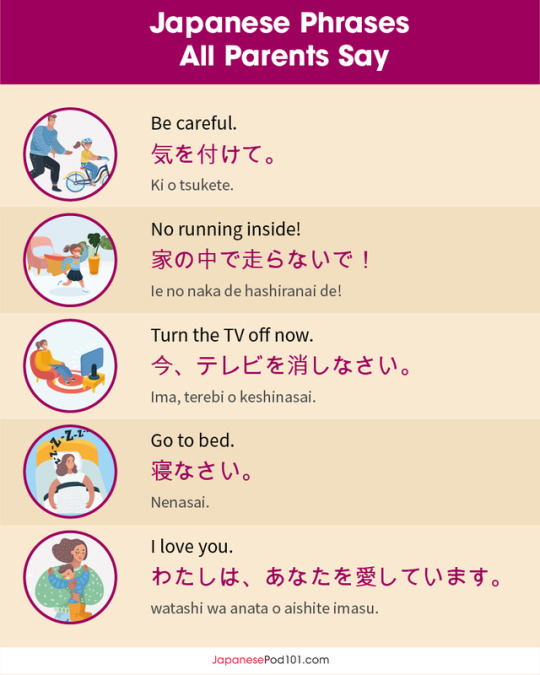
🗨👥 Phrases All Parents Say in Japanese! PS: Learn Japanese with the best FREE online resources, just click here: https://www.japanesepod101.com/?src=social_special_infograph_parents_022819
232 notes
·
View notes
Text

0.25 x 0.75
= ¼ x ¾
= 3/16 or 0.1875
れーてんにご かける れーてんななご は よんぶんのいち かける よんぶんのさん で じゅうろくぶんのさん もしくは れーてんいちはちななご
1K notes
·
View notes
Text
JLPT (2級)新完全マスター: 単語General Nouns ①
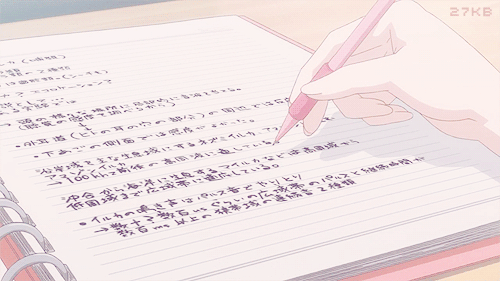
(*words from the 新完全マスター N2単語 book*)
一般名詞: あ~げ
(If the noun can also be used as a verb する will be added)
(**katakana words not included**)
1日目
合図するー signal (あいず)
あおむけー lie on your back
空きー empty (あき)
悪魔ー demon (あくま)
味見するー taste, try tasting (あじみ)
当たりー hit, win (あたり)
当たり前ー naturally, of course (あたりまえ)
悪化する ー worsen, deteriorate (あっか)
圧力ー pressure (あつりょく)
脂ー fat (あぶら)
現れー manifestation (あらわれ)
案ー plan (あん)
安定する ー stable (あんてい)
家出する ーrun away from home (いえで)
生きがいー reason to live (いきがい)
育児する ー childcare (いくじ)
意志ー will, intent (いし)
意識するー consciousness (いしき)
衣食住ーclothing food and lodging (いしょくじゅう)
意地悪するー mean, nasty (いじわる)
一部分ー part (いちぶぶん)
一面ー one side, as far as the eye can see (いちめん)
一流ー top class (いちりゅう)
一家ー family (いっか)
一種ー kind, type (いっしゅ)
2日目
一生ー lifetime, life (いっしょう)
一致するー consistent, unanimous (いっち)
一定するー constant (いってい)
移転するー transfer, move (いてん)
衣服ー clothes, clothing (いふく)
意欲ー motivation (いよく)
依頼するー request (いらい)
衣料ー clothes, clothing (いりょう)
衣類ー clothes, clothing (いるい)
飲食するー food and drink (いんしょく)
引退するー retirement (いんたい)
飲料水ー potable water (いんりょうすい)
打ち合わせー preliminary meeting (うちあわせ)
有無ー whether or not something is available (うむ)
運ー fortune (うん)
笑顔ー smile (えがお)
援助するー help, assist (えんじょ)
沿線ー along the railway, line-side (えんせん)
応対するー reception, response (おうたい)
応募するー apply (おうぼ)
応用するー apply (technique) (おうよう)
お気に入りー favorite (おきにいり)
おしゃれするー fashionable
お使いする ー errand (おつかい)
同い年ー same age (おないどし)
3日目
鬼ー demon (おに)
お参りするー visit (such as a temple) (おまいり)
お守りー amulet (おまもり)
恩ー favor, kindness (おん)
おんぶするー piggyback ride
可ー permitted, possible (か)
害ー harm (がい)
会見するー conference (かいけん)
外見ー outward appearance (がいけん)
会合するー meeting (かいごう)
開催するー hold, arrange (かいさい)
解散するー break up, dissolve (かいさん)
解釈するー interpret (meaning) (かいしゃく)
回収するー recover (things) (かいしゅう)
解除するー cancel (かいじょ)
解消するー solve, eliminate (かいしょう)
回数ー times (かいすう)
改善するー improve (かいぜん)
回答するー answer, respond (かいとう)
解凍するー thaw (かいとう)
開発するー develop (かいはつ)
回復するー recover (condition) (かいふく)
解放するー release, free from (かいほう)
開放するー open (かいほう)
外来ー foreign (がいらい)
4日目
回覧するー circulate (かいらん)
核家族ー nuclear family (かくかぞく)
覚悟するー readiness (かくご)
各自ー each individual (かくじ)
各種ー various (かくしゅ)
各地ー everywhere (かくち)
拡張するー broaden (かくちょう)
角度ーangle (かくど)
確認するー confirm, check (かくにん)
確率ー probability, chance (かくりつ)
陰ー shadow (space behind something) (かげ)
家計簿ー household accounts (かけいぼ)
可決するー approve (かけつ)
果実ー fruit (かじつ)
果汁ー fruit juice (かじゅう)
箇所ー point (as raised in a meeting) (かしょ)
数々ー numerous (かずかず)
加速するー accelerate (かそく)
塊ー lump, ball (かたまり)
活気ー lively (かっき)
活躍するー active (かつやく)
活用するー use (かつよう)
仮定するー assume (かてい)
過程ー process (かてい)
加入するー subscribe, take out policy (かにゅう)
5日目
鐘ー bell (かね)
加熱するー heat up(かねつ)
過半数ー majority (かはんすう)
紙くずー wastepaper (かみくず)
殻ー shell (から)
柄ー handle (がら)
火力ー thermal power (かりょく)
管ー pipe (かん)
感覚ー sense (かんかく)
換気するー ventilate, air out (かんき)
感激するー emotion (かんげき)
鑑賞するー appreciation (かんしょう)
勘定するー bill, count up (かんじょう)
観測 するー detect, observe (かんそく)
勘違いするー mistake for(かんちがい)
完了するー completion(かんりょう)
器械ー instrument, device (きかい)
機関ー organization (きかん)
貴金属ー jewelry, precious metal (ききんぞく)
機嫌ー mood (きげん)
記号ー symbol (きごう)
既婚ー married (きこん)
生地ー cloth, fabric (きじ)
基準ー standard (きじゅん)
起床するー get up(きしょう)
6日目
奇数ー odd number (きすう)
基礎ー foundation, basics (きそ)
議題ー agenda (ぎだい)
きっかけー trigger
機能するー function (きのう)
規模ー scale (きぼ)
決まりー It is a rule that… (きまり)
休暇ー vacation, holiday (きゅうか)
吸収するー absorb (きゅうしゅう)
急性ー acute (きゅうせい)
急増するー surge (きゅうぞう)
強化するー reinforce, strengthen (きょうか)
境界ー boundary (きょうかい)
競技するー competition (きょうぎ)
行儀ー behavior, manners (ぎょうぎ)
供給するー supply (きょうきゅう)
強調するー emphasize (きょうちょう)
共同するー jointly, cooperatively (きょうどう)
恐怖ー fear, be afraid (きょうふ)
教養ー cultured (きょうよう)
規律ー discipline, rules (きりつ)
緊急ー emergency (きんきゅう)
偶数ー even number (ぐうすう)
空想するー fantasy (くうそう)
くじー lottery
BONUS日
くずー scrap, crumbs
癖ー habit (くせ)
管ー tube (くだ)
苦痛ー pain, ordeal (くつう)
区分するー classify, divide (くぶん)
暮らしー living, daily life (くらし)
訓練するー training (くんれん)
計ー total (けい)
敬意ー respect (けいい)
警戒するー vigilance (けいかい)
傾向ー trend (けいこう)
警告するー warning (けいこく)
形式ー format (けいしき)
継続するー continue (けいぞく)
528 notes
·
View notes
Note
hello there! i would like to ask if you know any sites where i can practice reading japanese? like news sites, manga sites, or sites that offer free e-books that are in japanese. and are there any japanese podcasts that i can listen to? thank you in advance for answering this question. it'd mean a whole to me!
Hey there! There are actually quite a few recommended sites for Japanese learners, so I’ll link them right now :)
Japanese IO – I’ve used this site quite a few times and I love the interface! The design is really sleek and “to the point,” so there’s no distractions from what you’re trying to do, which is practice reading Japanese. It also has a great library and look-up feature.
朝日学生新聞社 – This is the “kid’s version” of the more adult 朝日新聞社. If you don’t feel that you’re quite up for the adult version, test out the version geared towards kids. They have fewer articles, but there’s plenty for a learner to pick through.
NHK NEWS EASY – I’m almost positive this is one of the most famous ones for learners. It’s similar to Asahi’s kid newspaper – articles are condensed with easier kanji and vocabulary, and it’s geared towards children, so learners can spend some time combing through updated articles and testing their skills.
Yahoo! Kids – More short news articles geared towards easier-to-understand Japanese.
MATCHA – A fun magazine similar in style to NHK EZ.
Watanoc – Another magazine-type site with a variety of articles.
Traditional Japanese Stories – Get your hands on some easily printed Japanese stories that are told to children. Great for language skills and culture! Similar to English pop culture stories (like Cinderella and so on), Japan has its own fairytales that are occasionally referenced.
Fuku Musume’s Fairy Tale Collection – More stories!
World of チョコチョコ – These are beginner stories, but as you progress you can read other stories on this website.
EhonNavi – Read hundreds of Japanese picture books for free!
If you’re looking for more advanced content…
NHK – Japan’s national broadcaster. You can read articles as well as stream audio and video (may be blocked depending on location).
毎日新聞 – Moderate/left-leaning national newspaper
朝日新聞 – Left-leaning national newspaper
読売新聞 – Conservative national newspaper
東洋経済オンライン – A well-known business and finance magazine.
Project Gutenberg (Japanese) – Get access to a ton of out-of-print and classical books for free.
小説家になろう – A site where authors can publish their works online in exchange for reviews.
青空文庫 – Another site where you can get older and out-of-print novels.
University of Virginia Japanese Text Initiative – Another place to access novels in Japanese for free (with the option to read them with furigana).
ComicWalker – Free manga from the publisher Kadokawa. There’s an app too!
最前線 – You can read some manga online for free.
コミコ – More free Japanese manga available here!
キナリノ – A woman’s lifestyle blog which covers fashion, cooking, decor, and more!
Magazine Lib – You can read PDFs of Japanese magazines.
1000文字小説 – A place where users can submit 1000 characters or less stories.
I also highly recommend starting a Twitter (if you don’t already have one) and following Japanese accounts. I follow a lot of feminist and political accounts so that I’m learning words relevant to my interests, as well as interacting with people that are discussing topics of interest to me (i.e. women and their place in Japanese society).
If you’re curious, you can find me on Twitter at @sydney0313 :)
I hope this list proves useful to you! (And others.)
頑張ってください!
6K notes
·
View notes
Text
Kanji Conundrums
The premise of this post would’ve made the title too squished so here it is: this post will mention a few pairs of words that have different readings/ definitions, but use the same kanji as each other. Duos like 王国/ 国王 are being excluded, as this post is only about words that use the same kanji in the same order, and 美味しい, 美味い, and 美味, seeing as they have okurigana to distinguish the three. With that out of the way, I hope this post is a pleasant read.
辛い (つらい and からい)
This duo’s particularly fun, since both words are relatively commonplace, so for new learners who only know one or the other, it might be quite confusing. However, since つらい means “painful/ difficult (for situations)” and からい means spicy, the words aren’t likely to be mixed up given context (which fortunately holds true for all of these sets of words).
空く (あく and すく)
These words have similar meanings, but are used in different contexts. あく is usually used to indicate a space is empty or vacant, or if (mostly a time) is free/ available. すく, on the other hand, is to get less crowded or get empty, but most importantly is used to say one’s hungry. The differences between these two verbs make them probably the trickiest to distinguish pair on this list in my opinion.
人気 (にんき, ひとけ, and じんき)
The only trio of words on this list, にんき’s lesser-known siblings are here to make their appearances. While every beginner knows にんき means popular/ popularity, the other two words aren’t quite as helpful. ひとけ means “signs of life, human presence” and じんけ means “the dominant mood of a local, the emotional climate of a district.”
下手 (へた and しもて)
へた is a rather common word, but like several others on this list, it has both an irregular reading and a conventional one, both of which mean different things. へた means “unskillful,” while しもて means “the lower part/ lower direction,” and “stage right.”
上手 (じょうず, うわて, and かみて)
じょうず mirrors its opposite へた, since it means skillful and also has another reading, うわて, which refers to stage directions (in this case, stage right). However, the reading かみて has its own niche, meaning both “the upper part,” and “upper stream.”
心中 (しんちゅう and しんじゅう)
An amusing set of words to share kanji, the two words of this pair have radically different meanings. しんちゅう means one’s true intentions/ motives (or literally in one’s heart), while しんじゅう refers to a lover’s/ double suicide.
罪人 (つみびと and ざいにん)
While most kanji compunds that can be read with either the kun’yomi of both kanji or the on’yomi of both kanji have exactly the same meaning regardless of readings (like 悪口 and 竹林), 罪人 stands as a bizarre exception. つみびと means a sinner, and ざいにん means a criminal. I remember which is which because the reading ざい for 罪 is used in other crime-related words like 犯罪, while 罪 read as つみ on its own means sin.
木馬 (もくば and きうま/ きんま)
These are two relatively obscure words, which I suppose justifies them both having the same kanji without any okurigana or otherwise to distinguish them. もくば means a wooden/ rocking horse, a vaulting horse (used in gymnastics), or the wooden torture device “the horse.” きうま (or きんま, they’re interchangeable readings), however, means a wooden sledge.
A Bonus Entry:
切手 (きって and きれて)
きって is a staple word, but rather unexpectedly has a more obscure relative. きれて means “a man of great ability/ talent,” but can also be written 切れ手, and tends to be to avoid confusion. Because きれて being written as 切手 is irregular, it only gets this honorable mention slot.
This is a topic I’ve wanted to cover for a while, but I left the draft, incomplete and neglected, to sit for a while before finishing it up. Thanks for reading!
695 notes
·
View notes
Photo

The Top 10 Japanese Slang Words You’ll Hear In Japan
Slang words can be a fun way to hear how locals use the Japanese language and can also be a way to make your conversational skills sound more natural in casual settings! Oh, and don’t forget to sign-up for a FREE lifetime account with us to get more interesting word lists from JapanesePod101!
And without further ado, let’s get into the top 10!
1. ぶっちゃけ bucchake - to be honest
2. おひさ。 Ohisa. - It’s been a while since I see you.
3. ちげーよ。 Chigē yo. - It’s not correct.
4. ダッシュで dasshu de - in a hurry
5. ソッコー sokkō - immediately
6. めちゃめちゃ mechamecha - quite
7. へこむ hekomu - feel discouraged
8. パねぇ pa nė - unbelievable
9. ガッツリ gattsuri - plentifully
10. やばい yabai - something is bad or dangerous
📚 Wanna learn more? Check out these fun word lists and don’t forget to sign-up for a FREE lifetime account!
501 notes
·
View notes
Photo
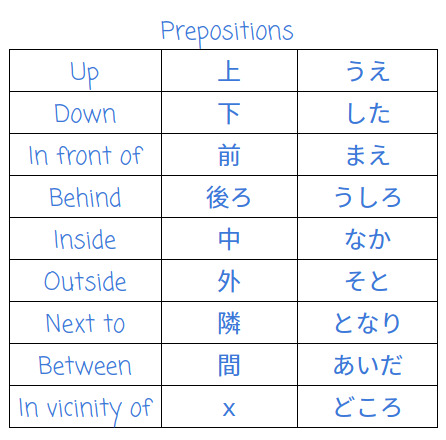
There are two forms of sentence structure you can use with prepositions.
topic は something の position(preposition) に あります・います
something の position に subject が あります・います
3K notes
·
View notes
Text
🦊Animals in Japanese🦊
動物(どうぶつ) Animals
さい Rinoceros 🦏
ライオン Lion 🦁
とら Tiger 🐅
とらの子 Tiger cub 🐯
ジャガーJaguar 🐆
ひょう Leopard 🐆
フラミンゴFlamingo
ふくろう Owl 🦉
白鳥(はくちょう) Swan
ペンギン Penguin 🐧
わしEagle 🦅
像(ぞう) Elephant 🐘
だちょう Ostrich
くまBear 🐻
こぐま Bear cub 🐻
白くまPolar bear
パンダ Panda 🐼
ゴリラ🦍Gorilla
おうむ Parrot
へび🐍 Snake
あざらし Seal
せいうち Walrus
らくだ🐪Camel
(らくだの)こぶ Hump 🐪
きつね🦊Fox
おおかみ Wolf 🐺
アリゲーター、わに Alligator 🐊
縞馬(しまうま) Zebra
きりん Giraffe
さるMonkey 🐒
かばHippopotamus
カンガルーKangaroo
しかDeer 🦌
とかげ Lizard 🦎
亀(かめ) Turtle 🐢
海亀(うみがめ) Sea turtle 🐢
角(つの) Horn 🐃
羽(はね)、翼(つばさ) Wings 🕊
羽毛(うもう) Feathers 🕊
くちばしBeak 🐓
たてがみ Mane 🦁
尾(お) Tail 🐒
しま Stripes 🐅
はん点(はんてん) Spots 🐆
299 notes
·
View notes

